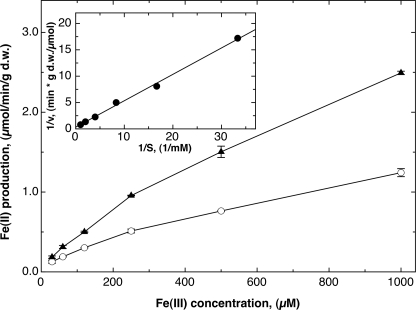FIGURE 6.
FetP functions as an iron reductase in vivo. An iron reductase assay was performed with E. coli strains ECA614 (glmS-fetP) (▴) and ECA611 (glmS-Gm) (○) in the presence of various concentrations of Fe(III) chloride. Formation of Fe(II) was recorded with 1 mm bathophenanthroline disulfonic acid (BPS) for 2 h at 37 °C at 520 nm using 0.132 mg dry weight (d.w.) of cells, obtaining a reduction rate of 1/min. An equilibration experiment yielded an absorption coefficient of 0.0695/nmol of Fe(II) under these conditions. This value was used to calculate the iron reduction rate in μmol/min/g dry weight, which was plotted against the Fe(III) concentration (three experiments, deviation bars shown). The inset shows a Lineweaver-Burk plot of the reciprocal difference between both curves (1/(vfetP − vcontrol)) against 1/S in 1/mm. A linear regression yielded an apparent vmax of 3 μmol of Fe(II)/min/g dry weight and an apparent Km of 1.5 mm Fe(III) (regression coefficient 99.8%).

